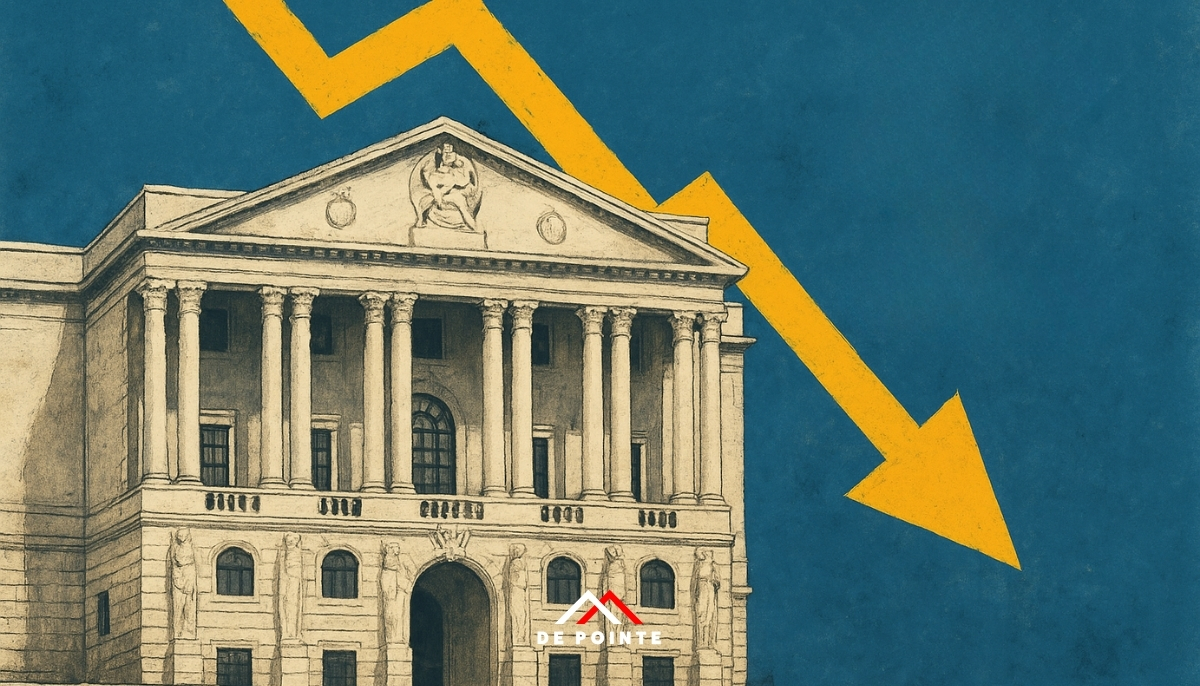Article

The Bank of England (BoE) is widely expected to cut interest rates this Thursday (8 August 2025), marking the fifth reduction since August 2024. If confirmed, this will bring the base rate down to 4%, the lowest level since March 2023. This move aims to support a stagnating UK economy, even as inflation continues to run above the central bank’s 2% target.
For investors, savers, and borrowers, this is a pivotal moment. In this blog, we break down what the expected rate cut means for your investment strategy, the economic outlook, and how to position your portfolio for the months ahead.
Why the Bank of England Is Cutting Rates (Again)
The BoE’s decision comes amid a widening gap between inflation and growth:
- UK inflation rose to 3.6% in June, driven by higher prices in food, clothing, air and rail travel.
- However, economic growth has flatlined, with zero growth in April and May, raising concerns of stagnation.
- Meanwhile, the labour market is cooling: payroll numbers are falling, job vacancies have dropped, and unemployment has edged higher.
Despite inflation being above target, the BoE appears more concerned about underlying economic weakness than persistent price rises. As Liz Martins, senior UK economist at HSBC, told the BBC:
“We are expecting more cuts… We forecast borrowing costs will fall to 3% by the latter part of 2026, but from today I think the Bank of England will be a bit cautious.”
Predictions: How Low Could Rates Go?
The expected 0.25% cut this week is part of a gradual easing cycle, and markets are already pricing in further reductions by year-end:
- BoE base rate prediction by the end of 2025: 3.50% – 3.75%
- UBS sees a longer easing path, projecting 3.00% by mid-2026
- Moneyfacts notes that SVR mortgage holders will save £40/month on a £250,000 loan if rates fall to 4%
But for savers, it’s a different story: the average savings rate has already dropped from 3.9% to 3.5% in a year and further declines are likely.
“Savings rates are getting worse and any base rate reductions will spell further misery for savers,” warns Rachel Springall of Moneyfacts.
What Investors Should Know: Asset Class by Asset Class
1. Equities: Room to Rally?
Lower interest rates reduce borrowing costs for companies and lift sentiment, especially in interest-sensitive sectors:
- Real estate, utilities, and infrastructure stocks may benefit from more substantial cash flow and refinancing conditions.
- Growth-focused businesses (especially in tech, biotech, and consumer discretionary) could outperform as capital becomes cheaper.
FTSE 100 is already up 12% year-to-date, and further rate cuts could bolster valuations further though inflation volatility may temper gains.
2. Bonds and Fixed Income: Yields Fall, Prices Rise
Rate cuts will likely push gilt yields lower, particularly on long-duration bonds. For fixed-income investors, this creates a window for:
- Capital gains on existing bond holdings
- New opportunities in corporate bonds and high-grade municipal debt
- Potential downside if inflation remains elevated and erodes real returns
Strategy: Consider locking in current yields before further cuts compress returns.
3. Property and Mortgages: A Mixed Bag
Lower base rates translate to reduced mortgage repayments, which could boost affordability:
- Standard Variable Rate (SVR) holders may save ~£40/month on average
- Fixed-rate borrowers may benefit when refinancing later this year
- Buy-to-let landlords and property investors may see improved margins
However, a sluggish economy and higher landlord operating costs (including rising National Insurance and wage bills) could dampen sentiment in the rental sector.
4. Savings and Annuities: Not So Rosy
Savers face declining returns as banks adjust their products in line with the base rate. This affects:
- Cash ISAs, fixed-rate bonds, and lifetime ISAs
- Annuity pricing, which may become less favourable for retirees
If you’re approaching retirement, consider locking in higher-paying annuity rates before further BoE cuts.
5. Alternative Investments: Gold, Art, and Inflation Hedges
As central banks shift toward looser policy, investors often seek tangible assets as inflation hedges and stores of value:
- Gold tends to perform well when real rates are falling.
- Art and collectables offer low correlation to traditional markets and are not impacted by interest rate changes in the same way.
At De Pointe Research, we advise a 10–20% allocation to alternatives, particularly during periods of policy uncertainty.
What About the Pound?
Cutting rates typically weakens the currency in the short term. While GBP/USD may face near-term softness, UBS expects a rebound to 1.40 by mid-2026, driven by diverging US/UK policies and long-term capital flows.
Exporters could benefit in the short run, but FX traders should brace for volatility around economic data and MPC minutes.
Investor Checklist: What to Do Next
| Task | Action |
| Review asset allocation | Tilt toward equities and longer-duration bonds |
| Lock in savings rates | Shop for best fixed-rate ISAs before further cuts |
| Monitor BoE forecasts | Focus on GDP, labour market, and inflation projections |
| Explore alternatives | Art, gold, and collectables for long-term diversification |
| Rebalance exposure | Avoid over-concentration in interest-sensitive areas |
What Comes Next?
- Thursday, 8 August 2025 – BoE rate decision at 12:00 pm
- Next week – ONS GDP release for Q2 (April–June); a key signal for the economy’s direction
- Autumn Budget – Chancellor may introduce tax increases to plug the gap left by weak growth
As always, the BoE’s tone and forward guidance will shape market sentiment as much as the rate cut itself. Investors should be prepared for a cautious but persistent easing path, especially if inflation falls and labour market weakness intensifies.
While borrowers may welcome the relief, and markets may cheer lower yields, investors must stay nimble. This is not a return to ultra-loose monetary policy but rather a calibrated response to economic stagnation.
Whether you’re planning to remortgage, restructure your portfolio, or hedge against uncertainty, De Pointe Research is here to help you navigate the new financial landscape.






